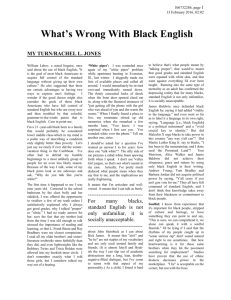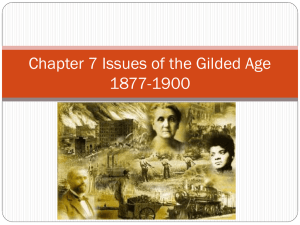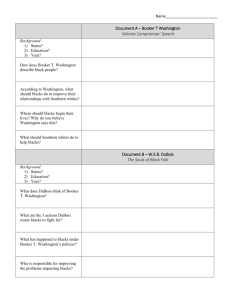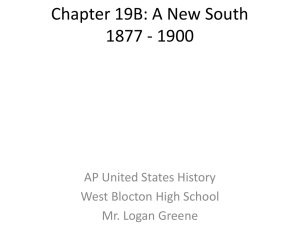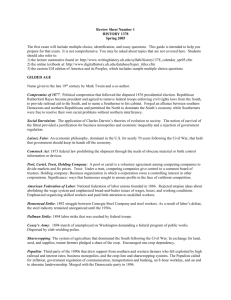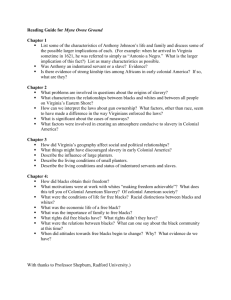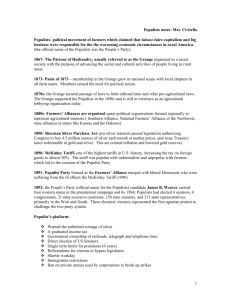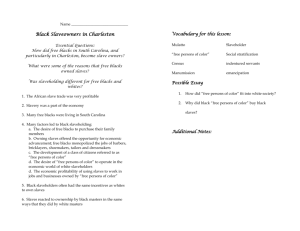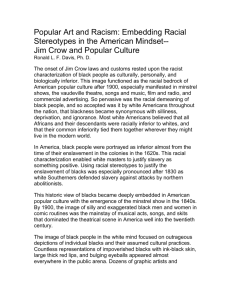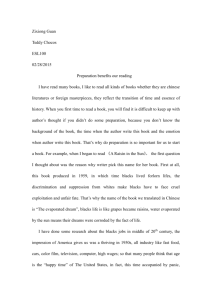Chapter 11: The Peculiar Institution
advertisement
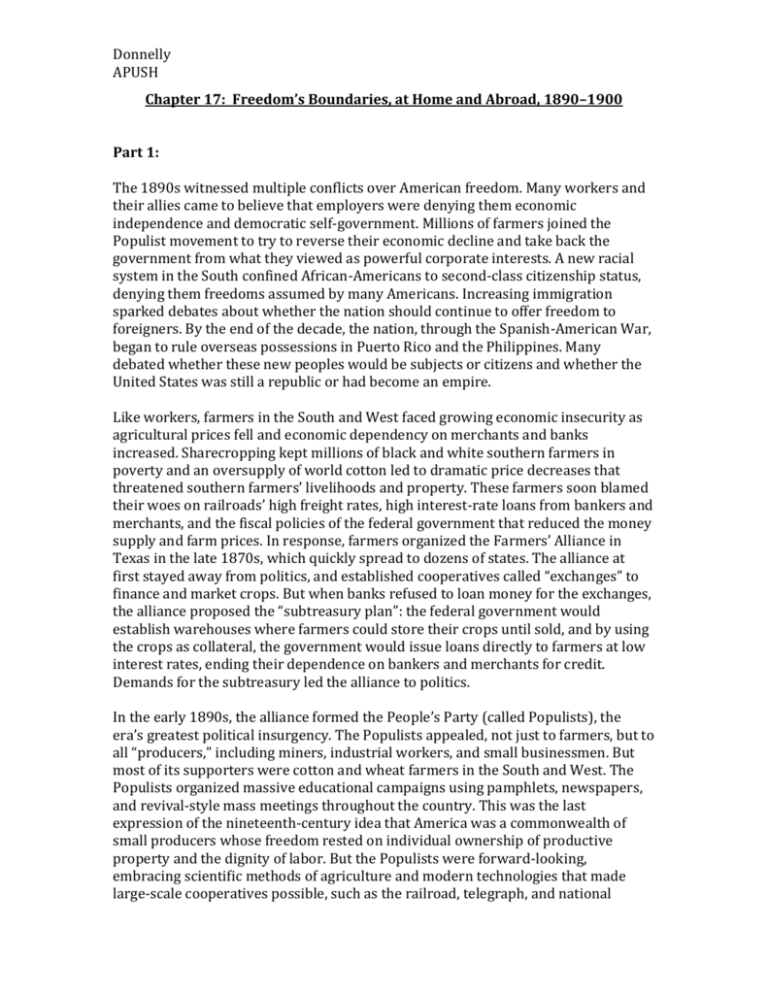
Donnelly APUSH Chapter 17: Freedom’s Boundaries, at Home and Abroad, 1890–1900 Part 1: The 1890s witnessed multiple conflicts over American freedom. Many workers and their allies came to believe that employers were denying them economic independence and democratic self-government. Millions of farmers joined the Populist movement to try to reverse their economic decline and take back the government from what they viewed as powerful corporate interests. A new racial system in the South confined African-Americans to second-class citizenship status, denying them freedoms assumed by many Americans. Increasing immigration sparked debates about whether the nation should continue to offer freedom to foreigners. By the end of the decade, the nation, through the Spanish-American War, began to rule overseas possessions in Puerto Rico and the Philippines. Many debated whether these new peoples would be subjects or citizens and whether the United States was still a republic or had become an empire. Like workers, farmers in the South and West faced growing economic insecurity as agricultural prices fell and economic dependency on merchants and banks increased. Sharecropping kept millions of black and white southern farmers in poverty and an oversupply of world cotton led to dramatic price decreases that threatened southern farmers’ livelihoods and property. These farmers soon blamed their woes on railroads’ high freight rates, high interest-rate loans from bankers and merchants, and the fiscal policies of the federal government that reduced the money supply and farm prices. In response, farmers organized the Farmers’ Alliance in Texas in the late 1870s, which quickly spread to dozens of states. The alliance at first stayed away from politics, and established cooperatives called “exchanges” to finance and market crops. But when banks refused to loan money for the exchanges, the alliance proposed the “subtreasury plan”: the federal government would establish warehouses where farmers could store their crops until sold, and by using the crops as collateral, the government would issue loans directly to farmers at low interest rates, ending their dependence on bankers and merchants for credit. Demands for the subtreasury led the alliance to politics. In the early 1890s, the alliance formed the People’s Party (called Populists), the era’s greatest political insurgency. The Populists appealed, not just to farmers, but to all “producers,” including miners, industrial workers, and small businessmen. But most of its supporters were cotton and wheat farmers in the South and West. The Populists organized massive educational campaigns using pamphlets, newspapers, and revival-style mass meetings throughout the country. This was the last expression of the nineteenth-century idea that America was a commonwealth of small producers whose freedom rested on individual ownership of productive property and the dignity of labor. But the Populists were forward-looking, embracing scientific methods of agriculture and modern technologies that made large-scale cooperatives possible, such as the railroad, telegraph, and national market, and they wanted the federal government to regulate them for the public interest, a very twentieth-century idea. The Populists adopted a famous platform at their 1892 Omaha convention. It proposed many measures to restore democracy and economic opportunity for ordinary Americans, some of which came to pass in the next century, such as direct election of U.S. senators, government control of currency, a graduated income tax, low-cost public financing for farmers, and workers’ right to organize unions. The platform also called for national ownership of railroads to allow farmers to inexpensively get their crops to market. In some parts of the South, the Populists heroically tried to unite black and white farmers on a common political and economic program, but the barriers were too great. Racism, the legacy of the Civil War, and the fact that many white Populists were landowning farmers while black farmers were tenants and agricultural laborers facing a different set of problems all militated against such an alliance. Black farmers organized their own Cotton Farmer’s Alliance, whose strikes were suppressed by white authorities, some of whom were even sympathetic to white Populists. While white Populists were hardly anti-racist, some recognized that whites would have to appeal to blacks in order to break the Democratic Party’s hold on the South and its opposition to reform, and in a few places, like North Carolina, white and black Populists together won state elections. In most of the South, however, Democrats defeated the Populists by mobilizing whites to vote against “Negro supremacy,” intimidating blacks, and rigging elections. The Populists also engaged the reform efforts of farmer and middle-class women, and endorsed women’s suffrage in many states. In 1892, the Populist candidate for president, James Weaver, won more than 1 million votes, and the party carried five western states and elected three governors and fifteen members of Congress. When a severe depression in 1893 intensified conflict between labor and capital, it seemed that the Populists might gain the votes of industrial workers who had traditionally supported the two major parties. Employers used state or federal authority to protect their economic power and suppress labor unrest. In May 1894, the federal government dispersed Coxey’s Army, a march of the unemployed led by Ohio businessman Jacob Coxey that converged on the nation’s capital. Also in 1894, workers in Pullman, Illinois, who manufactured railroad cars for the Pullman company went on strike against pay cuts. When the 150,000 members of the American Railway Union, a union of skilled and unskilled workers led by the charismatic Eugene V. Debs, refused to work on Pullman cars and thus paralyzed the nation’s rail traffic, President Grover Cleveland won an injunction from federal courts that ordered the strikers back to work. Violence between strikers and troops from Maine to California left 34 dead, and when union leaders, including Debs, were imprisoned for violating the injunction, the strike collapsed. The Supreme Court reaffirmed Debs’s sentence in a famous ruling approving the use of injunctions against strikes. Debs claimed that powerful capitalists aligned with state and national government now infringed on Americans’ freedoms. 2 In 1894, the Populists doubled their efforts to appeal to industrial workers, and in state and congressional elections that year, with the depression worsening, voters abandoned the Democrats. The Populist vote in rural areas increased, but most workers did not vote Populist. Few Populist demands spoke to workers’ needs, as their calls for higher agricultural prices would raise food costs for workers and diminish the value of their wages, and the movement’s Protestant and revivalist culture alienated Catholic and immigrant workers. Urban workers instead voted for the Republicans, who argued that higher tariff rates would revive the economy by protecting American manufacturing and workers from imports and cheap foreign labor. The Republicans gained a massive 177 seats in the House. In 1896, the Democrats and Populists united behind presidential candidate William Jennings Bryan, a young congressman from Nebraska. Bryan had won the Democratic nomination in a speech that captured the fears and hopes of farmers. Bryan called for the “free coinage” of silver (the unrestricted minting of silver money), and he used Biblical imagery to condemn the gold standard in perhaps the most famous lines of political oratory in American history: “You shall not press down upon the brow of labor this crown of thorns. You shall not crucify mankind upon a cross of gold.” Bryan’s demand for free silver was the latest expression of a long-standing view that increasing the amount of currency in circulation would raise the prices of farmers’ crops and make it easier for them to pay their debts. Bryan’s nomination represented a shift in Democratic leadership away from elites live Cleveland who had long been tied to eastern businessmen. But Bryan’s appeal was highly religious and revivalist, and influenced by the Social Gospel. Part 2 Republicans argued gold was the only “honest” currency, and that abandoning it would prevent economic recovery by scaring creditors away from making loans. They nominated Ohio governor William McKinley, who passed the highly protectionist McKinley Tariff in Congress in 1890. The 1896 election was the first modern presidential election. The Republicans poured an unprecedented amount of money into a highly organized campaign that used a massive educational effort directed against the Democrats’ calls for free silver. The results showed a nation divided along regional lines. McKinley won the election with the votes of industrial states in the Northeast and Midwest. Labor conflict did not produce political results. Party politics seemed to mute class conflict, not reinforce it. Industrial America, from workers to industrialists, voted solidly Republican, and continued to do so for years. McKinley’s victory shattered the political stalemate of the previous twenty years, launched a period of Republican dominance that would last until the 1930s, and marked a height in voter participation, which ever since has been in decline. Populism’s defeat in the South allowed for the imposition of a new racial order. The Redeemers, a coalition of merchants, planters, and businessmen who ruled the region after 1877 and claimed to have “redeemed” the south from the corruption and horrors of “black rule,” worked to reverse Reconstruction’s achievements. They reduced taxes and public spending, and cut back public schools, which especially 3 hurt blacks. New laws allowed the arrest of those without employment and increased punishment for petty crimes. As the South’s prison population rose, convicts, mostly poor blacks, were rented out to railroad, miners, and lumber companies as cheap, involuntary labor, at a high profit. Labor unions in the South assailed the convict labor system. In the 1880s, Atlanta editor Henry Grady relentlessly promoted the dream of a New South in which industrialization and agricultural diversification would deliver prosperity to the region. While planters, merchants, and industrialists prospered, the region as a whole became more impoverished. While mining and textiles developed in some areas, the region’s low wages and taxes and convict labor did not spur much economic development. By 1900, except for the major iron and steel city of Birmingham, Alabama, southern cities had little industry and mostly exported cotton, tobacco, and rice. The South as a whole stayed dependent on the North for capital and manufactured goods. Black farmers, the most disadvantaged rural southerners, suffered the most from the region’s economic condition. In the Upper South, mines, iron mills, and tobacco factories offered some jobs to black workers, and some black farmers owned land. In the rice kingdom of coastal South Carolina and Georgia, the plantations went to ruin, and many blacks acquired land and became self-sufficient farmers. In most of the Deep South, however, blacks owned a smaller percentage of land in 1900 than they had in the late 1870s. In southern cities, institutions such as schools, churches, businesses, and clubs created by blacks during Reconstruction formed the basis of dynamic black urban communities. But the labor market was racially divided, and black men were excluded from skilled and professional occupations, while black women were limited to wage-work as domestic servants, and were excluded from occupations open to white women. Most unions in the South excluded blacks from membership. Blacks, trapped at the bottom of an economically stagnant South, emigrated by the tens of thousands. In 1879 and 1880, nearly 60,000 African-Americans moved to Kansas, seeking political rights, safety, and education and economic opportunity. Its participants called the move the Exodus, named after the biblical account of the Jews’ flight from slavery in Egypt. But despite worsening conditions, most blacks had no choice but to stay in the South. While economic expansion took place in Northern cities, most employers there offered jobs only to white migrants from rural areas and European immigrants, not blacks. Only in World War I did jobs open up for blacks, helping spur a massive movement northward called the Great Migration. Despite Redemption, blacks continued to hold office and vote in the South after 1877. Even while Democrats restructured southern politics to limit blacks’ political power and representation, blacks continued to hold office in states and Congress. But black political opportunities diminished in this period. Talented and ambitious black men increasingly avoided politics and entered business, law, or the church. 4 Black women became political leaders, and “respectable” middle-class black women pressed for women’s rights and racial progress through organizations like the National Association of Colored Women, formed in 1896. In some states, however, blacks continued to vote and Republicans stayed competitive with Democrats. By the 1890s, however, Populist and Republican-led state governments, such as North Carolina’s, fell to racial violence and electoral fraud. Between 1890 and 1906, every southern state enacted laws or constitutional provisions intended to eliminate the black vote. Because the Fifteenth Amendment prohibited the use of race as a qualification for the suffrage, southern lawmakers designed laws that seemed color-blind, but were meant to keep blacks from voting. Most popular were the poll tax (a fee citizens must pay to be eligible to vote), literacy tests, and a requirement that a voter show an “understanding” of the state constitution. Although some white leaders presented disenfranchisement as a “good government” measure that would end fraud and violence in elections, it was a means for ending black participation in politics, and it worked—by 1940, only 3 percent of adult blacks in the South were registered to vote. Poor and illiterate whites were also disenfranchised by these laws. Disenfranchisement led to a generation of southern “demagogue” politicians who mobilized white voters by appealing to their racism. And disenfranchisement could not have occurred without Northern approval. In 1891, the Senate defeated a proposal to protect black voting rights in the South, and the Supreme Court approved disenfranchisement laws. According to the Fourteenth Amendment, any state that deprived its male citizens of the franchise was supposed to lose part of its representation in Congress, but this was not held to apply to blacks. Thus southern congressmen had far greater power than their small electorates warranted. Alongside disenfranchisement in the 1890s, segregation was imposed throughout the South. Laws and local customs that required separating the races had existed in the North before the Civil War, and during Reconstruction, southern schools and other institutions had been segregated. In the 1880s, though, race relations in the South were fluid, with some railroads, theaters, and hotels admitting blacks and whites, while others discriminated. In 1883, the Supreme Court invalidated the Civil Rights Act of 1875, which had outlawed racial discrimination by hotels and other public facilities, and held that the Fourteenth Amendment banned unequal treatment by state authorities, not private business. In the landmark 1896 ruling Plessy v. Ferguson, the Court approved state laws requiring separate facilities for blacks and whites, arguing that segregated facilities did not discriminate as long as they were “separate but equal.” States responded to Plessy by passing laws requiring segregation in every part of southern life, in schools, hospitals, toilets, and cemeteries. Despite the doctrine of “separate but equal,” facilities for blacks were either inferior or nonexistent. Segregation was an important part of a system of white supremacy in the South, in which each part, such as disenfranchisement, economic inequality, inferior education, reinforced the others. Segregation did not so much keep races apart as 5 ensure that whites would have the advantage wherever they did meet. A racial social etiquette developed, in which blacks had to give way to whites on sidewalks and could not raise their voices at whites or otherwise be assertive. Blacks who challenged white supremacy or refused to accept the indignities of segregation faced political and legal power and immediate violent reprisal. In each year between 1883 and 1905, more than fifty persons, most of them black, were lynched (killed by a mob) in the South. Lynching continued well into the twentieth century. Some were secret, others were public and promoted by organizers and the media. Lynchings often resulted in atrocities against the victims, and law enforcement rarely prevented lynching or punished lynchers. Many victims were accused of having raped or assaulted white women, an allegation often without basis. But many white southerners considered preserving white womanhood a sufficient basis for extrajudicial murder. Lynching is virtually unknown as a phenomenon anywhere else in the world. The reconciliation of the North and South in the 1880s and 1890s came at the cost of widespread hopes for racial equality that had existed during and after the Civil War. In popular literature and at veterans’ reunions, the war came to be remembered as a tragic quarrel between brothers, in which blacks had played no role, and which had been caused by clashes over states’ rights and the preservation of the Union, not slavery. Reconstruction came to be universally seen as a period of black misrule imposed on the South by the North, a view which legitimized disenfranchisement and segregation in the South. Southern governments and schools celebrated the “Lost Cause” of the Confederacy and condemned the evils of Reconstruction. Part 3 The effective nullification of Reconstruction-era laws and amendments and the making of blacks into second-class citizens reflected trends across the nation. America seemed to be fracturing along racial and class lines in the late nineteenth century. One observer noted that the result was a far-reaching obsession with redrawing the boundary of freedom by identifying and excluding those unworthy of freedom’s blessings. Many Americans seemed to adopt a more exclusive definition of nationhood and national identity. Immigrants were increasingly seen as a threat to Americans’ sense of identity and traditions. This was largely due to a change in the sources of immigration to the United States. Despite prolonged depression, 3.5 million immigrants came to the United States in the 1890s, looking for industrial work in the Northeast and Midwest. They came not from Ireland, England, Germany, or Scandinavia, as had earlier European immigrants, but from nations in southern and eastern Europe, particularly Italy and the Russian and Austo-Hungarian empires. These “new immigrants” were seen as members of distinct “races” whose lower level of civilization was held to explain their acceptance of low-paying jobs and their innate criminality. The Immigration Restriction League, founded in Boston in 1894, called 6 for reducing immigration by barring the illiterate from entering the country. This measure was adopted by Congress in 1897 but vetoed by President Cleveland, though most states adopted the secret ballot as a means of disenfranchising immigrants, many of whom did not read English and thus had had their ballots cast by party workers. States stopped allowing immigrants to vote before they had become citizens and imposed new residency and literacy requirements. Along with black disenfranchisement in the South, suffrage seemed more and more a privilege, not a right. Although single Chinese men had been welcomed as cheap contract labor in the West, when Chinese families started to migrate in the 1870s, Congress barred women from migrating. In 1883, Congress temporarily excluded all Chinese immigrants from entering the country. This was the first time that race had been used to exclude an entire group of people from entering the U.S., and it was made permanent in 1902. When exclusion occurred, more than 100,000 people of Chinese descent lived in America, mostly on the West Coast, and they suffered intense discrimination and occasional mob violence. States like California discriminated against the Chinese in education and other areas. While the Supreme Court upheld the right of Chinese to pursue a living and the citizenship of Chinese born in the United States, the Court also affirmed the right of Congress to erect racial restrictions on immigration. Social movements that helped to expand nineteenth-century boundaries of freedom now revised their goals so they could be achieved in the new economic and intellectual environment. Some black leaders, for example, started to emphasize self-help and individual self-advancement into middle-class America as an alternative to politics. Booker T. Washington symbolized this change in black life. In 1895, Washington delivered a speech at the Atlanta Cotton Exposition urging blacks to accommodate segregation and cease agitation for civil and political rights. He founded the Tuskegee Institute in Alabama, a center for vocational training (education for jobs, not broad liberal arts), as he believed obtaining farms and skilled work was more important than full citizenship for blacks. He told a white audience in Atlanta, “In all things that are purely social we can be as separate as the fingers, yet one as the hand in all things essential to mutual progress.” Whites who wanted a docile labor force that would not form unions and work cheaply embraced his vision, while many blacks supported him from a belief that direct assaults on white power were failures and that blacks should build up their own communities. The dissolution of the Knights of Labor and the rise of the American Federation of Labor (AFL) in the 1890s signaled in the labor movement a similar move away from broad reforms to more limited aims. Strikes like the Pullman strike seemed to show that direct confrontations with capital devastated workers’ organizations. Unions, declared Samuel Gompers, the AFL’s founder and longtime president, should avoid seeking economic independence, politics, or the utopian goals of groups like the Knights. Gompers and the AFL thought unions should simply bargain with 7 employers for higher wages and better working conditions. Like Washington, Gompers used the language of the era’s business culture; his strategy was known as “business unionism.” He embraced the idea of freedom of contract and turned it into an argument against the interference of judges with workers’ right to organize unions. In the 1890s, union membership recovered from its decline in the late 1880s. But the AFL unions that grew abandoned the Knights’ ideal of labor solidarity, and restricted its membership to skilled workers, a small minority of workers, which effectively excluded most unskilled workers, who were mostly blacks, women, and new European immigrants. The AFL became strong in trades with highly skilled workers, like printing and construction, but was weak or nonexistent in basic industries like steel or the factories that dominated the economy. Changes in the woman’s movement reflected the same expansion of activity and narrowing boundaries. The 1890s began what would be called the “women’s era”— three decades in which women, though still denied the vote, had greater opportunities for economic independence and a role in public life. Nearly 5 million women worked for wages by 1900, and though most were young, unmarried, and worked in traditional women’s jobs such as domestic service and garments, a new generation of college-educated women were taking better-paid white-collar jobs. Women also had more influence in politics and society, through a number of new organizations, like the Women’s Christian Temperance Union, founded in 1874, which moved from demanding prohibition laws to demanding comprehensive economic and political reform, including the vote. Yet, feminism in this period moved away demanding equal rights to claims more in line with dominant racial and ethnic norms. While “equal rights feminism” was never fully repudiated, the mostly native-born, white and middle-class women who dominated the suffrage movement laid claim to the vote as members of a “superior race,” and complained that unworthy non-whites, such as immigrants, had the vote while white women did not. Part 4 America’s narrowed definition of nationhood was projected abroad in the late 1890s, as the United States became an imperial power in the world. The last quarter of the nineteenth century is known as the age of imperialism, when rival European empires divided large parts of the world among themselves. In this period, the United States was considered a second-rate power and not included in imperial competition and diplomacy. Although large land-based empires such as the Russian, Ottoman, and Chinese empires and overseas empires such as the British, French, and Spanish, dominated much of the nineteenth century, after 1870 a “new imperialism” emerged, dominated by European powers and Japan. Belgium, Great Britain, and France consolidated their colonies in Africa, and Germany acquired colonies on that continent. The British and Russians intensified their struggle to 8 control Central Asia, and all European powers competed to control parts of China. By the early twentieth century, most of Africa, Asia, the Middle East and the Pacific had been divided among these empires, each of which justified its domination of other peoples in the name of bringing civilization to backward peoples who required instruction in Western values, government, Christianity, and labor practices. Territorial expansion had been part of American life from the beginning, but the 1890s marked a major transformation of America’s relationship to the rest of the world. Americans more and more saw their nation as an emerging world power. Until the 1890s, the expansion of the United States had been in North America, though the Monroe Doctrine shows that many Americans had seen the Western Hemisphere as an American sphere of influence. Americans talked of acquiring Cuba, the Dominican Republic, and other territories, but the only territory acquired after the Civil War was Alaska, regarded by many as worthless. Most who looked overseas wanted to expand trade, not take new possessions. Many farmers and manufacturers believed that America’s production could no longer be absorbed in domestic markets, and thought “overproduction” was causing recurrent economic crisis. They wanted foreign customers for their products. Christian missionaries actively spread American influence overseas in the late 19th century. Groups like the Student Volunteer Movement for Foreign Missions believed it was their mission to prepare the world for Christ’s second coming and enlighten the heathens abroad. A few late-19th century thinkers actively promoted American expansionism. Josiah Strong, a well-known Congregationalist clergyman, tried to update manifest destiny in his book, Our Country (1885). Here he argued that AngloSaxon Americans, who had shown their ability for liberty and self-government in North America, should spread their institutions and values to “inferior races” overseas whom, he suggested, would benefit American manufacturers by becoming new consumers of their goods. Naval officer Alfred T. Mahan, in The Influence of Sea Power Upon History (1890), argued that no nation could prosper without a large merchant fleet engaged in international trade and a powerful navy to protect it, which required overseas bases. Mahan insisted that with the western frontier closed, Americans had to look overseas for opportunity. Mahan influenced James G. Blaine, President Harrison’s Secretary of State, who advocated the acquisition of Hawaii, Puerto Rico, and Cuba for naval bases. In 1893, American planters in Hawaii organized a rebellion there that overthrew the native Hawaiian government of Queen Liliuokalani. Though Harrison asked the Senate to pass a treaty of annexation, President Cleveland withdrew it. In 1898, during the Spanish-American War, the United States annexed the Hawaii islands. The depression that began in 1893 intensified Americans’ belief that an aggressive foreign policy would create markets for manufactured goods. All these factors contributed to America’s emergence as a world power in the Spanish-American War of 1898. But the war’s immediate cause was Cubans’ long struggle for national independence from Spain. Ten years of guerrilla warfare began in 1868, and revolt resumed in 1895. Reports of Cuban civilians suffering in Spanish 9 detention camps aroused outrage and sympathy in America. Cries for intervention increased after February 15, 1898, when an explosion, probably accidental, destroyed the Maine, an American battleship in Havana harbor, killing 270 sailors. When Spain rejected American demands for a cease-fire and eventual Cuban independence, the Congress approved President McKinley’s request for a declaration of war, which was justified as a humanitarian intervention. Congress adopted the Teller Amendment, declaring that the United States had no intention of annexing or dominating Cuba. The war was brief and resulted in only a few hundred American casualties, what one official called a “splendid little war.” The war’s most important battle actually happened in the Pacific Ocean, in Manila Bay in the Philippines, a Spanish colony, where Admiral George Dewey defeated a Spanish fleet. The most publicized land battle of the war involved the assault on San Juan Hill, outside Santiago, Cuba, made by Theodore Roosevelt’s Rough Riders. Roosevelt was pro-expansionist and believed war would unite the nation and its men, whose masculinity he thought had suffered in the economic crisis of the 1890s. Although Roosevelt organized the Rough Riders to be a cross-section of America, it excluded blacks, and Roosevelt neglected to mention that black troops had actually reached the top of San Juan Hill before his troops. But Roosevelt’s exploits made him a national hero, and after being elected New York’s governor that fall, he became McKinley’s vice-president in 1900. The war to liberate Cuba soon became an imperial mission that culminated with the creation of a small overseas American empire. McKinley would not return the Philippines to Spain or hand it over to the Filipinos who had fought for independence, because he didn’t believe they could govern themselves. He also spoke of Americans’ duty to “uplift and civilize” the Filipinos and train them to rule themselves. In the treaty ending the war, the United States acquired the Philippines, Puerto Rico, and Guam. Before McKinley recognized Cuba’s independence, he forced that island’s new government to approve the Platt Amendment to the new Cuban constitution, which gave the United States the right to intervene in Cuba with its military whenever it saw fit. Cuban patriots were extremely disappointed by what they saw as America’s betrayal, and such resentments would help inspire the revolution in Cuba fifty years later. Americans’ interest in their new insular possessions had more to do with trade than settlement or extracting resources, however, and they sought Cuba and Puerto Rico, and in the Pacific, the Philippines, Guam and Hawaii, as outposts for trade to Latin America and Asia. In 1899, secretary of state John Hay declared the Open Door Policy, demanding that European powers which had divided China into commercial spheres of influence allow equal trade access to America. Western influence and presence in China soon led to the Boxer Rebellion, in which Christian Chinese and foreigners were targeted by Chinese nationalists, and American troops helped quell the uprising. 10 While many Cubans, Filipinos, and Puerto Ricans had welcomed American intervention as a means to wrest independence from Spain, continued American control, direct and indirect, quickly alienated these patriots and others. After victory in the Philippines, Emilio Aguinaldo, the leader of the independence movement there, established a provisional government with a constitution modeled on that of America. When McKinley decided to retain possession of the islands, the Filipinos rebelled. A second longer and far more bloody war ensued, lasting from 1899 to 1903, and costing the lives of more than 100,000 Filipinos and 4,200 Americans. The war was hotly debated in the United States, where reports of atrocities against Filipino civilians, including burning villages, torture, and rape and executions, seemed to damage America’s image as a liberator. McKinley’s administration justified the war as an effort to “uplift and civilize and Christianize” the Filipinos (most residents were already Catholics). The American colonial government, led by William Howard Taft, quickly modernized the islands with railroads, schools and public health officials, and modern agriculture. But American policies in its new possessions tended to favor land-based local elites, whether native-born or American, and usually created persistent poverty for the majority. American rule came with American racial attitudes. In an 1899 poem, British writer Rudyard Kipling asked the United States to take up the “white man’s burden” of imperialism. American supporters of empire felt that white domination of nonwhite peoples represented the progress of civilization. But America’s new empire sparked an intense debate about the relationship between democracy, race, and American citizenship. America’s governmental system had no provision for permanent colonies, and the right of every people to self-government was a key principle of the Declaration of Independence. Jefferson’s idea of America as an “empire of liberty” assumed that new territories would eventually be admitted as new states, and its residents would be American citizens. Yet after the Spanish-American War, nationalism, democracy, and American freedom seemed aligned with ideas of Anglo-Saxon supremacy. Both Democratic and Republican leaders who wanted to retain the new possessions feared negative consequences of incorporating “alien races” into America. The Foraker Act of 1900 declared Puerto Rico an “insular” territory different from previous territories in the American West. Its 1 million inhabitants were defined as citizens of Puerto Rico, not the United States, and were denied a future path to statehood. Filipinos were given the same status. In a series of cases decided between 1901 and 1904 known as the “Insular Cases,” the Supreme Court ruled that the Constitution did not fully apply to overseas territories held by the United States, thus sharply limiting the extent of American freedom. Congress had to recognize the fundamental rights of these new peoples, but could otherwise govern them as it saw fit for an indefinite time. Hawaii became a traditional territory and was admitted as a state in 1959. The Philippines became independent in 1946. Although Congress gave American citizenship to Puerto Ricans in 1917, Puerto Rico has the status of a “commonwealth,” neither a state or a territory, which has its own government but lacks a voice in Congress and presidential elections. 11 America’s racial attitudes had a global impact in the age of imperialism. Global concerns about immigration, race relations, and the “white man’s burden” seemed to inspire solidarity among “Anglo-Saxon” nations. Chinese exclusion and segregation in the Jim Crow South influenced discriminatory laws in Canada, South Africa, and Australia. Other nations seemed to learn from Reconstruction’s “failure” that multiracial democracy was impossible. America’s new empire caused intense debate and controversy. Opponents formed the Anti-Imperialist League, which united writers and social reformers who wanted reforms at home, businessmen who thought overseas empire was too expensive, and racists who did not want non-whites brought within the United States. The League warned Americans that empire was incompatible with democracy and urged Americans to help Puerto Ricans and Filipinos gain their independence. In 1900, the Democrats once again nominated William Jennings Bryan to run against President McKinley, and the Democrats’ platform opposed the Philippine War for militarily subjugating a foreign people demanding “liberty and self-government.” The president of the Anti-Imperialist League declared that the nation’s most pressing question was whether the nation would be a “republic or empire?” Proponents of American empire embraced the language of freedom, too. Senator Albert Beveridge of Indiana argued that America sought abroad not material resources or national power but desired only to bring freedom to other peoples. America practiced a “benevolent” imperialism that would uplift backward cultures and spread liberty. America, Beveridge argued, only went abroad for trade, not to rule other nations. McKinley, benefiting from economic recovery and a swell of patriotism from winning the Spanish-American war, beat Bryan in 1900. At the start of the twentieth century, America seemed ready to become a great power. Writers at home and abroad predicted that American influence would soon pervade the globe. In his book The New Empire, Brooks Adams, the grandson of John Quincy Adams, predicted that America’s economic might would make it “outweigh any single empire, if not all empires combined.” This did not happen until after World War II, but the characteristics that would constitute America’s global strength were already present in 1900. The United States had already surpassed Britain, France, and Germany in industrial production, the merger movement of 1897–1904 left much of the economy controlled by corporations, politics had stabilized and the white North and South had reconciled, while hardened racial lines—segregation, Chinese exclusion, Indian reservations—limited the boundaries of citizenship and freedom. Yet questions central to nineteenth-century debates over freedom, such as the relationship between economic and political liberty, the role of government in creating the social conditions for freedom, and the definition of citizenship and national identity, had not been finally answered. They would continue to be central to American life in the twentieth century. 12 13
